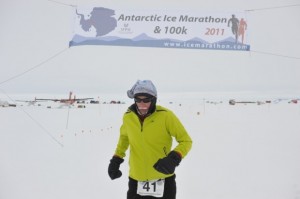Two stories this week raise the issue of what we are talking about when we talk about extreme sports.
Typically, the term is used to describe anything really dangerous and really unusual: physical activities pursued by a few people at the far end of the bell curve of crazy. (Base jumping. Street luge. Outrunning avalanches by paragliding off a cliff on skis.) By this definition, extreme sports demand strength and resilience and ultra-sharp reflexes, and that in turn means that older athletes are more or less excluded.
So then what do we call men like this? Brent Weigner (62) and Don Wright (70) are both are accomplished athletes. Both perform under extremely challenging conditions. Both are astride the long, whipping tail of the bell curve.
On December 1, in the face of a -12F wind chill, Weigner finished the Antarctic Ice Marathon and 100K in a time that broke the world record in the over-60 age group. He now holds a world mark for running marathons and ultramarathons seven times on all continents. He also became the oldest person in the world to run an ultramarathon (anything over a regular marathon) in Antarctica. The former Wyoming middle school teacher is the only person in the world who has run ultramarathons at both the Geographic South Pole and the Geographic North Pole. Given what’s happening to the polar ice cap, that distinction might be his for the rest of time.
As stunning as that is, the achievements of Don Wright seem even more astonishing. Eight years ago, Wright was diagnosed with myeloma, a cancer of the blood and bone marrow. He has run 60 marathons in 41 states since then, and his best time is 3:36, which is pretty damn decent for a runner at any age, let alone one with the (let’s call it) hindrance of cancer. He owes his remarkable performance to (we assume) rigorous training and a daily dose of pomalidomide, an anti-cancer drug that is still in clinical trials.
Every so often someone publishes a story about promising advances in the war on cancer, but Gizmodo’s profile of Wright (by Kristen Philipkoski) is enough to make you feel that real progress is around the corner. Pomalidomide and a handful of other drugs “could make treating cancer as relatively manageable as taking insulin for diabetes or a statin for high cholesterol.”
Is there any way that these are not stories of extreme sport: running in multiple marathons (and longer), post 60, through the frigid wilderness, with myeloma? The athletes are clearly several standard deviations away from normal. And yet…and yet…we don’t sense the danger. (Risk-free? No. But no more risky than a lot of other activities we take for granted.) In fact, it seems to us, for older athletes “extreme” sports are less about taunting death and much more about keeping their devotees very much alive.
Photo of Brent Weigner by Mike King, via the Casper Star-Tribune.










